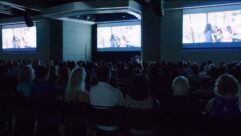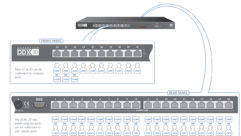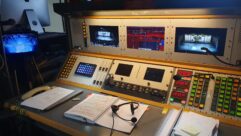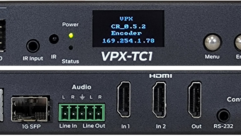Signal Switch
how the lack of analog TV will affect their constituents, a recent news article reports.
FEEDBACK
MANY AMERICANS aren’t aware of the impending analog TV shut-off on Feb. 17, 2009, and Congress is “becoming concerned” how the lack of analog TV will affect their constituents, a recent news article reports.
Actually, Congress seems more concerned about how the lack of analog TV will affect their re-election chances. Senators and representatives are having nightmares that involve their phone lines and e-mail inboxes jammed with complaints from angry citizens demanding to know “who took away my TV?”
The fact is, Mr. and Mrs. Average American are only now starting to realize that analog TV is indeed going away, and it’s not coming back. Given that better than 80 percent of Americans get their TV primarily via cable feeds, that may not seem like a big problem. But those second and third TVs that use rabbit ears will go dark, and that is a big problem. Folks with vacation homes not wired for cable or satellite are in the same boat.
Several groups have started campaigns to educate consumers about the switchover to digital TV, most notably the National Association of Broadcasters. Earlier this year, it hired seasoned lobbyists and Capitol Hill staffers to put together a digital TV (DTV) transition awareness campaign, the fruits of which were first seen at NAB 2007.
Also among the efforts is a sample constituent letter that any member of Congress can send — and, presumably, put out any fires before they start — explaining how the switchover will affect primary and secondary TVs, as well as accessories connected to that TV.
For consumers, most of the pieces are in place to make the switch as smooth as possible. The National Telecommunications & Information Administration (NTIA) Digital-to-Analog Converter Box Coupon Program appears ready to roll out on schedule. Households are eligible for up to two $40 vouchers toward a universal, no-frills DTV-to-NTSC converter until the supply of coupons (about 37 million) runs out.
Go into most any store selling new flat-panel or rear-projection TVs, and you’ll find that most of them are equipped with ATSC tuners. Products as mundane as VHS players and DVD recorders are also starting show up with ATSC reception capability. In July, TiVo released a $299 HD DVR that incorporates ATSC, NTSC, and QAM tuning.
Indeed, sales of smaller CRT TVs have plummeted for Chinese manufacturers, as retailers in the United States turn a thumbs-down on any television set not equipped with DTV reception capability. LG will sell their $60 DTV converters through mainstream retailers, while Samsung plans to sell a more costly unit ($75) through the Internet and upscale retail outlets.
The potential problems for consumers are nothing compared to what broadcasters are facing. There aren’t enough manufacturers to fill all of the orders for back-up 8VSB transmitters by Feb. 17, 2009, nor are there enough tower crews to do the skyhook work required to install primary and secondary antennas.
There will also be a big game of musical chairs as we get closer to “D-Day,” thanks to the fact that channels 52 to 69 will be taken out of service permanently and auctioned off for broadband, emergency, and cellular services. Stations that are now operating on temporary DTV channels in that range will have to relocate below channel 52.
Stations whose existing analog channel falls in the same range have the same problem, while those stations unfortunate enough to have their analog and DTV assignments out of the “core” (channels 2-51) really have their hands full. In some markets I’ve visited, there are DTV stations that can’t move until another station vacates a particular frequency (usually a temporary DTV channel assignment).
In Albany, N.Y., WNYA, a DTV station, can’t even go on the air until the existing DTV station on their assigned channel (WNYT) moves down from VHF channel13 to VHF channel 12. Similar jumps will take place in Syracuse, N.Y., New York, and Philadelphia. In New York state, there are numerous DTV stations assigned to VHF channel 7 that aren’t all that far from each other. (Can you say co-channel interference?)
On the station management level, there are numerous issues regarding DTV monitoring and staff education that must be resolved. ATSC digital TV monitoring involves a fair amount of knowledge about RF and MPEG, and neither is something the average techie can gain a comprehensive understanding of within a day or so. It takes time.
How many control room technicians know the steps involved to encode and decode an 8VSB signal? How many know what a correctly modulated 8VSB waveform looks like?
In addition, how many can use a transport stream analyzer, and understand what PIDs, MER, PSIP, CRC, and TEI mean? How about null packets, MPEG program number errors, and PMT and PAT errors?
Other issues include closed captioning (switching to EIA708 from EIA608 captions), upgrading feeds of signals from DTV stations to cable head ends and direct broadcast satellite companies, handling digital audio levels and dialogue normalization (dialnorm), and processing audio metadata correctly for commercials. (Dolby 2.0? Dolby 5.1? No dialogue at all, just music?)
Media monitoring companies also have to re-work their front ends to log commercials. If there’s picture, but no audio, is a make-good required? If the audio track is delivered as Dolby surround, but the playback is Dolby 1.0 or 2.0, is that grounds for a make-good? If the commercial is mastered in HD but played back as SD letterboxed, is that grounds for a make-good?
You might wonder how this will affect our industry. The fact is, many clients are now asking for terrestrial DTV reception capability with their new or retrofit installations as a consequence of Sept. 11. At InfoComm, several companies were showing integrated flat-panel HDTVs for exactly that reason.
Support for DTV makes sense for other reasons. Sure, having HDTV for free is nice, but many stations also multicast sub-channels with 24/7 weather services. PBS stations carry educational and kid’s programming on their sub-channels. We may even see 24/7 news channels available before long.
You can also demodulate the 8VSB signal and distribute the MPEG video and audio programs via IP networks, coax, or fiber to multiple locations. Or, those programs can be multiplexed into a new stream with other MPEG sources, if you want to build a private “pure IP” video and audio network.
From all accounts, it makes perfect sense to discard an analog TV system that is becoming a relic of the 20th century and move ahead with digital program distribution. The only question is, will all of the movers and shakers involved get their respective acts together before Feb. 17, 2009?
To comment on this article, e-mail the Pro AV editorial staff at [email protected].
Pete Putman is a contributing editor for Pro AV and president of ROAM Consulting, Doylestown, Pa. Especially well known for the product testing and development services he provides to manufacturers of projectors, monitors, integrated TVs, and display interfaces, he has also authored hundreds of technical articles, reviews, and columns for industry trade and consumer magazines over the last two decades. You can reach him at [email protected].










